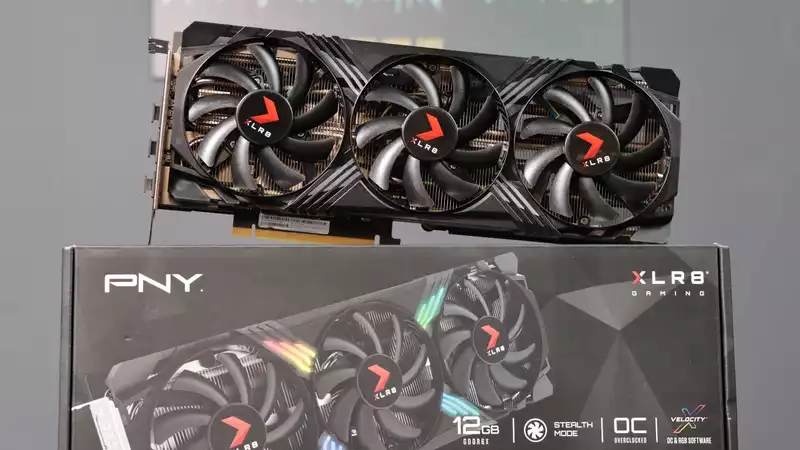The RTX 4070 Super is the first of Nvidia's refreshed Ada GPUs to hit the market, with two more to follow this month. We covered this new chip in detail in our Founders Edition review of the Nvidia RTX 4070 Super, and we also got our hands on an overclocked version, the PNY RTX 4070 Super XLR8.
Or, if you want to use a ridiculous official title, the PNY GeForce RTX 4070 Super 12GB XLR8 Gaming VERTO EPIC-X RGB Overclocked Triple Fan edition. Yay.
Actually, I find the factory overclocked versions of standard graphics cards a tricky proposition. A decade ago in the gaming industry, overclocking made a certain amount of sense. Graphics cards had a predetermined clock speed, and to get more than that, you had to either go deep into the settings yourself and overclock the card, or pay the manufacturer to overclock it at the factory.
In other cases, it may be worth paying extra to get a little more performance out of the GPU, as the manufacturer may have a specific cooler or special overclocking wisdom to get the most out of the silicon. It will also give you the confidence to overclock even harder, knowing that the factory overclocked card has the power components and cooling to make it possible.
This is not the case today, as there are dynamic clock speeds that vary on the fly depending on cooling and power available to the GPU; with Nvidia's OC Scanner, you can even dial in a specific chip. It is an automatic feature that tests different power levels and provides voltage curves specific to your silicon.
In other words, the graphics card is already essentially pushing itself within a certain power limit, towards the limits of what is possible with each GPU. Also, factory overclocked cards are becoming increasingly irrelevant. Frankly, it has been that way for generations now.
The RTX 4070 Super's AD104 specs were covered in the main review, with the CUDA core count increased from 5888 to 7168 and a little extra L2 cache. Other than that, it is basically the same as the RTX 4070, which unfortunately cannot be fully replaced, with 12GB GDDR6X on a 192-bit memory bus and a boost clock of 2475 MHz. RTX 4070 Super's base clock is compared to the reference RTX 4070 GPU nominally 60 MHz higher, but in front of the dynamic clock speeds, it is rather irrelevant, to be honest.
The base clock of this PNY RTX 4070 Super XLR8 remains the same at 1,980MHz, but what differs is the boost clock. The factory overclock is 30 MHz. Yes, only 30 MHz. Your expensive card's boost clock is 2,505 MHz, since that's what factory overclocks are like these days. In dollar terms, the price will probably increase about the same. We don't know the final price of this model before launch, but looking at other overclocked RTX 4070 Super cards, $630 seems quite likely.
So should we be willing to pay $1 for each MHz added to the boost clock of the card? Paying extra for such a factory overclocked card does the end user no favors.
In my own testing, PNY cards are on average 3% faster at 1080p, 0.28% faster at 1440p, and about 1% slower at 4K. Basically, pretty much the same performance for the money. It's certainly not as loud, but it's also not as loud as the reference version. But it is definitely warmer. By only a few degrees, but the triple-fan PNY cooler is definitely not as efficient at cooling chips as the over-engineered matte black Nvidia shroud.
In short, the PNY RTX 4070 Super XLR8 should not be purchased expecting performance advantages in terms of frame rate, cooling, noise level, etc.
When Nvidia releases a GPU with a Founders Edition card, our guidelines are generally the same. Reference GeForce cards are guaranteed to be sold at MSRP and are often also the highest performing versions of the cards.
However, they are sometimes sold out for this reason, which often forces us to choose third-party cards. Still, I would say that your best bet is to find a GPU that is priced at Nvidia's MSRP rather than spending the extra for the temporary benefit of the factory overclocking option.
Spending $600+ for an RTX4070 Super is a bit of a hurdle; for nearly $100 less and only 10% slower, the older Ada is still attractive.
But if the only option is the $30 more expensive OC version, you won't suffer with a PNY RTX 4070 Super XLR8 on your rig. The cooler is as effective and quiet as ever, and the refreshed AD104 GPU is a very impressive slice of graphics silicon that offers gaming performance that is only slightly behind the RTX 4070 Ti and, at the generation level, even surpasses the older RTX 3080 Ti. With DLSS Frame Generation, it is also a very efficient graphics card, offering the dual benefits of Frame Generation.
Just don't expect any additional performance from the new card's modest 30MHz overclock.
.

Comments